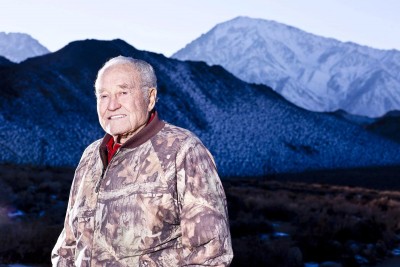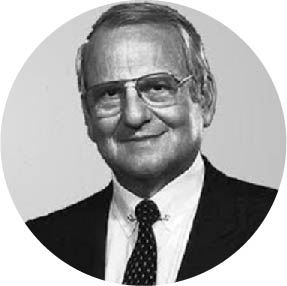
Dave McCoy said he’s a fun-loving man, not a businessman.
And that quest for fun and adventure, he said, has led to his long and successful life. McCoy, founder of Mammoth Mountain Ski Area, turns 100 on Monday.
“Longevity happens because you do something fun,” McCoy said recently, sitting in his office at his rambling ranch home north of Bishop in the foothills of the Sierras.
His office walls are blanketed with family photos documenting decades of Mammoth Mountain, a vision he made reality in 1948 when he got a special-use permit for a permanent ski location on the remote – still volcanic – mountain. That permit allowed McCoy to bring alpine skiing to Southern Californians.
Today, Mammoth Mountain is a sprawling resort that draws 1.3 million skiers and snowboarders annually.
And that’s just the winter crowd. In the summer, the mountain and its surrounding hiking trails and passes are a playground for outdoor adventurers and mountain bikers – attracting almost double the number of people compared with the winter months. Three weeks ago, Mammoth Mountain drew 50,000 professional mountain bikers from across the country to the USA Cycling Mountain Bike National Championships.
The vision
As a young hydrographer for the Los Angeles Department of Water and Power, McCoy spent his early years in the Sierra skiing the backcountry, measuring snowpack to predict the following year’s water supply. He covered most of Owens Valley and made $4 a day.
In 1935, he and some buddies built his first rope tow out of an old truck frame and engine to haul skiers uphill in Gray Meadows near Independence – an iconic mining town along Highway 395. They built it for themselves for weekend play. But word spread, and others came to see what all the ruckus was about skiing.
In the U.S., at that point, the sport had not scratched the surface of the popularity it would generate after the 1960 Winter Olympics at Squaw Valley. But McCoy, proficient in other sports, fell in love.
“I don’t know why I liked it so much,” he said. “I just did. I just loved having slippery boards under my feet.”
At 21, McCoy began working with fellow hydrographers measuring snowpack on Mammoth Mountain. Despite it being lonely backcountry at the time, he saw an opportunity as he skied Mammoth’s steep canyons and wide bowls. He also saw abundant snow. Thus began his dream.
McCoy recalled many people saying his plan to create a ski mountain there couldn’t be done. They said the slopes were too isolated, too windy and too high. They said there was too much snow.
“I knew better,” he said. “I knew the runs there were perfect, and I knew we’d never have to worry about snow. All we had to worry about were material things like lifts.”
By the early 1950s, thousands came to the Eastern Sierra to ski. McCoy – always innovative – installed diesel engines in rope tows to make them faster, at the time among the fastest in the nation.
By 1952, the U.S. Forest Service began looking at plans to make Mammoth Mountain a full-service ski area. They built paved roads to Mammoth’s north side and put out a prospectus seeking $250,000 to put together a European-style ski area with a chairlift and lodge.
When no investor surfaced, the service went back to McCoy. He was given a 25-year lease, and he agreed to build a chairlift on the north side of the mountain.
In 1953, he began running a free rope tow for friends. It was so much fun, he said, his friends offered to help. Others heard, and came offering various skills.
“We had 1,000 people, and each person was friendly to the other,” McCoy said. “We built that mountain with people who loved to do what they wanted to do there. I didn’t know I could do it. I knew it had to be done.”
Some worked for a pittance, others out of friendship and some for the love of skiing. They cleared trails, cutting trees by ax and handsaw. In some cases, McCoy said, he made his own tools.
“We didn’t go out to get people,” he said. “For some reason they fell into our laps. Everyone was ‘Mammoth.'”
On Thanksgiving 1955, McCoy opened Mammoth Mountain’s first lift. Every lodge and motel along the 395 was packed. The price of the lift ticket – $4.
Roma McCoy, Dave’s wife, rode the inaugural chair. The day was a dream come true, he said.
He continued expanding the mountain and started a ski team. By the 1960s, Mammoth had become a racing mecca and even European skiers sought out McCoy for training.
In one year, McCoy said, he had 14 Olympic racers on his team.
“I was crazy enough to make them think they were better people,” he said.
Gary McCoy is the eldest of Dave and Roma’s six children. Now 73, he can remember how it all got going.
“Whatever he was doing, I was always alongside him,” Gary McCoy said of his father. “When we started building up the lifts, I’d dig ditches and run heavy machinery. I don’t think any of us ever realized how big it would get.”
Fueled by enthusiasm
By 1972, six more chairlifts had opened. In 1978, Rusty Gregory got a job working there.
Gregory, who grew up in Arcadia and spent summers on Balboa Island in Newport Beach, was done with college. He went to Mammoth Mountain to learn to ski and live the mountain lifestyle for a season. He has yet to leave, and now is chief executive of the Mammoth Mountain Ski Area.
Gregory recalled the first time he met Dave and Roma McCoy. He was working at Chair 16 and held it for the couple to get on.
“Everybody knew Dave and Roma,” he said. “They were this incredibly athletic, good-looking couple.”
Gregory got to know McCoy more when he was promoted to the mountain’s chairlift maintenance and construction department. McCoy was fascinated with machinery, motors and technology and spent a lot of time there.
“He was a real innovator in mountain operations,” Gregory said of McCoy. “Dave always shared his discoveries and new ideas with people at other resorts. That was part of his unbridled enthusiasm.”
In 1986, McCoy bought June Mountain. His plan was to link it with Mammoth Mountain and turn the area into a large European-style resort. The politics of keeping the wilderness undeveloped altered the path.
Over the years, McCoy said, he received offers to work on other resorts for big money, but he wasn’t interested.
“I was working to make things good at Mammoth Mountain,” he said. “I always looked at how tomorrow would be better. I never worried about money.”
In the 1980s, when snowboarding started to evolve, some thrill-seekers came up to Mammoth Mountain. McCoy remembers pulling boarders up the mountain on snowcats after hours and watching them try out tricks.
It was also in the 1980s that McCoy developed another of his passions for others to enjoy. When the snow melted, McCoy realized the opportunity the mountain offered for mountain biking and motorcycle racing. Mammoth Motocross is now the longest-standing competition in the country.
Vancouver-based Intrawest bought a significant share of the mountain in 1996, but McCoy and his wife kept a controlling share.
“That was our mountain,” McCoy said. “It was our area. There were plenty of people who wanted to enjoy it. Money wasn’t in the way, it was (too little) time. We had such a little amount of time between seasons to make it better.”
But he kept at it – always looking for faster lifts and making better terrain.
And despite Mammoth’s generally abundant snowfall, McCoy made sure the mountain could make its own during the drought years.
“I knew good things were happening and if there were bad things, I just dug a little deeper,” he said.
Michael Berry, president of the National Ski Areas Association, knew McCoy. Berry ran Kirkwood Mountain Resort near Lake Tahoe then. To him, McCoy was top-notch.
“He without a doubt contributed more on many levels than almost any operator in the U.S., both with the reality of having to run the ski areas in terms of innovation and his unending support of the competitive scene of racing programs at Mammoth,” Berry said. “Dave truly, truly is one of those rare individuals that defined the ski industry and what it has become today.”
More than 50 years later, after building 38 chairlifts and more than 4,000 acres of skiable terrain between Mammoth and June, McCoy passed the reins of Mammoth Mountain to the next generation.
“I felt it was something other people could do better than I could, the way the business was changing,” he said.
Building the town
McCoy last put on his Salomon skis 10 years ago, and he hasn’t been back to the mountain since selling it in 2006. But what he has done is helped grow the town around the mountain through his Mammoth Lakes Foundation, which he started in 1989. It operates on an annual budget of $1 million.
In addition to the ski area, McCoy launched the town’s first water district, fire department, high school and college. When McCoy started the foundation, there were no college students in Mammoth Lakes. Now there are 500 attending the town’s campus of Cerro Coso Community College. About 650 scholarships have been given out to students who may otherwise never have had a college opportunity.
The foundation owns and operates the 100-seat Edison Theatre and the 59-bed South Gateway Student Apartments. It owns 40 acres of land around the campus, which are being held for future expansion and community benefit.
Plans for a 300-seat state-of-the-art regional theater are in the works, and ground could be broken next year.
“Dave is the greatest educator and motivator I have ever known,” said Evan Russell, who worked on the mountain for McCoy for decades and now runs the foundation. “I feel we have been the luckiest people in the world getting to work for Dave, and I hope Dave becomes the oldest person in the world some day.”
At nearly 100, McCoy still goes into his home office every day, plants himself in his leather commander chair and starts opening a mountain of mail, personally answering as much of it as time allows. He enjoys reading the Inyo Register and the Mammoth Times. He loves the Los Angeles Lakers.
“During basketball season, his mood is very much correlated to the result of the Lakers game the night before,” said Brandon Russell, McCoy’s assistant. The two have known each other since Russell was a baby.
“It’s a real honor to sit here with him and spend so much time by his side,” Russell, 33, said. “It’s been enlightening to see that despite what he’s done, he operates on the same plane as the rest of us. Most of what I do here is new to me, and I had no idea how to handle it, things like printing photos, framing, social media and blogging. I’d never done any of that before, and he gave resources and time to go out and learn what I needed and gave me the tools to do it well.”
When he’s not surrounded by his children, grandchildren and great-grandchildren, McCoy still spends a lot of time outdoors, mostly riding his Rhino, an all-terrain vehicle, with Roma, who turned 95 Aug. 12. And just as he did with Mammoth Mountain, McCoy said, he continues to push himself to make tomorrow better than today.
McCoy was an innovator among builders of ski areas and resorts around the world. His spirit of innovation still burns inside.
For the past eight years he researched and worked on converting a gas-powered side-by-side vehicle to electricity.
This summer, after nearly eight years of research and development, the vehicle was finished and licensed for off-road use as well as transportation on public roads.
“I’ve got a new machine, and it’s better than any equipment out there in the auto field,” he said. “It runs on solar power and in a week, it’ll be better than it is now. And I’ll be out there playing in the sun.”
McCoy said people ask him about his secret to longevity.
“Life is what we make it as individuals,” he said.
“Everyone has a different life. But longevity happens because you do something fun. I just wish I had a hundred more years. There’s a hundred more things I want to do.”
Original Post – http://www.ocregister.com/articles/mccoy-678850-mountain-mammoth.html

